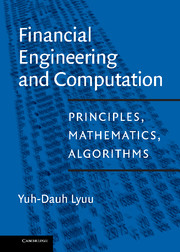Book contents
- Frontmatter
- Contents
- Preface
- Useful Abbreviations
- 1 Introduction
- 2 Analysis of Algorithms
- 3 Basic Financial Mathematics
- 4 Bond Price Volatility
- 5 Term Structure of Interest Rates
- 6 Fundamental Statistical Concepts
- 7 Option Basics
- 8 Arbitrage in Option Pricing
- 9 Option Pricing Models
- 10 Sensitivity Analysis of Options
- 11 Extensions of Options Theory
- 12 Forwards, Futures, Futures Options, Swaps
- 13 Stochastic Processes and Brownian Motion
- 14 Continuous-Time Financial Mathematics
- 15 Continuous-Time Derivatives Pricing
- 16 Hedging
- 17 Trees
- 18 Numerical Methods
- 19 Matrix Computation
- 20 Time Series Analysis
- 21 Interest Rate Derivative Securities
- 22 Term Structure Fitting
- 23 Introduction to Term Structure Modeling
- 24 Foundations of Term Structure Modeling
- 25 Equilibrium Term Structure Models
- 26 No-Arbitrage Term Structure Models
- 27 Fixed-Income Securities
- 28 Introduction to Mortgage-Backed Securities
- 29 Analysis of Mortgage-Backed Securities
- 30 Collateralized Mortgage Obligations
- 31 Modern Portfolio Theory
- 32 Software
- 33 Answers to Selected Exercises
- Bibliography
- Glossary of Useful Notations
- Index
7 - Option Basics
Published online by Cambridge University Press: 19 September 2009
- Frontmatter
- Contents
- Preface
- Useful Abbreviations
- 1 Introduction
- 2 Analysis of Algorithms
- 3 Basic Financial Mathematics
- 4 Bond Price Volatility
- 5 Term Structure of Interest Rates
- 6 Fundamental Statistical Concepts
- 7 Option Basics
- 8 Arbitrage in Option Pricing
- 9 Option Pricing Models
- 10 Sensitivity Analysis of Options
- 11 Extensions of Options Theory
- 12 Forwards, Futures, Futures Options, Swaps
- 13 Stochastic Processes and Brownian Motion
- 14 Continuous-Time Financial Mathematics
- 15 Continuous-Time Derivatives Pricing
- 16 Hedging
- 17 Trees
- 18 Numerical Methods
- 19 Matrix Computation
- 20 Time Series Analysis
- 21 Interest Rate Derivative Securities
- 22 Term Structure Fitting
- 23 Introduction to Term Structure Modeling
- 24 Foundations of Term Structure Modeling
- 25 Equilibrium Term Structure Models
- 26 No-Arbitrage Term Structure Models
- 27 Fixed-Income Securities
- 28 Introduction to Mortgage-Backed Securities
- 29 Analysis of Mortgage-Backed Securities
- 30 Collateralized Mortgage Obligations
- 31 Modern Portfolio Theory
- 32 Software
- 33 Answers to Selected Exercises
- Bibliography
- Glossary of Useful Notations
- Index
Summary
The shift toward options as the center of gravity of finance […]
Merton H. Miller (1923–2000) [666]Options grant their holder the right to buy or sell some underlying asset. Options are therefore contingent claims or derivative securities because their value depends on that of the underlying asset. Besides being one of the most important classes of financial instruments, options have wide-ranging applications in finance and beyond. As far as explaining empirical data goes, the option pricing theory ranks as the most successful theory in finance and economics [766].
Introduction
There are two basic types of options: calls and puts. More complex instruments can often be decomposed into a package of calls and puts. A call option gives its holder the right to buy a specified number of the underlying asset by paying a specified exercise price or strike price. A put option gives its holder the right to sell a specified number of the underlying asset by paying a specified strike price. The underlying asset may be stocks, stock indices, options, foreign currencies, futures contracts, interest rates, fixed-income securities, mortgages, winter temperatures, and countless others [54, 346, 698]. When an option is embedded, it has to be traded along with the underlying asset.
The one who issues an option is called a writer. To acquire the option, the holder pays the writer a premium. When a call is exercised, the holder pays the writer the strike price in exchange for the stock, and the option ceases to exist.
- Type
- Chapter
- Information
- Financial Engineering and ComputationPrinciples, Mathematics, Algorithms, pp. 75 - 83Publisher: Cambridge University PressPrint publication year: 2001



